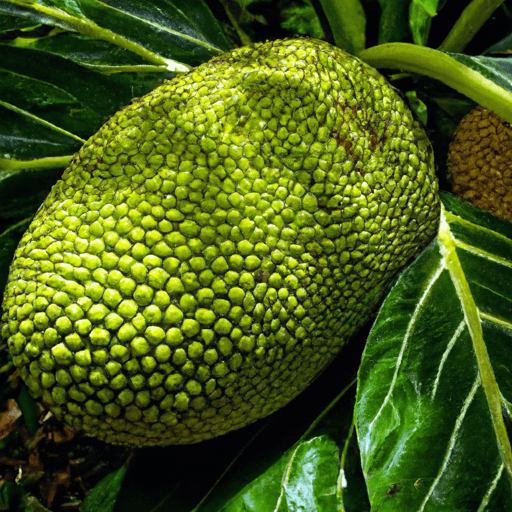Embracing the Versatility of Breadfruit
If you’re on the hunt for an intriguing and highly versatile ingredient, look no further than breadfruit. This tropical fruit, known for its starchy flesh and unique flavor, has been delighting palates and satisfying hunger for centuries. Whether you’re a seasoned chef or an aspiring home cook, breadfruit offers a world of culinary possibilities.
A Tropical Taste Sensation
Breadfruit is renowned for its distinctive taste that is often likened to a mix between fresh bread and a potato. Its rich and mildly sweet flavor profile makes it incredibly enticing for both sweet and savory dishes. When cooked, the texture of breadfruit ranges from tender to slightly chewy, depending on the cooking method and ripeness of the fruit.
The Many Faces of Breadfruit in the Kitchen
1. Roasted Breadfruit Wedges
One of the simplest and most satisfying ways to enjoy breadfruit is by roasting it. Start by cutting the fruit into wedges, removing the tough outer skin and core. Toss the wedges in olive oil, sprinkle with your favorite herbs and spices, and roast until golden brown. The result is a delicious side dish or a filling snack with a delightful crispy exterior and a soft, creamy interior.
2. Vegan Pulled “Pork”
Yes, you read that right! Breadfruit can be transformed into a plant-based pulled “pork” that will surprise and delight even the most dedicated carnivores. By boiling or steaming the fruit until tender and then shredding it, you can achieve a texture remarkably similar to pulled pork. Mix in your favorite barbecue sauce or seasoning, and you have a delectable and sustainable alternative to traditional pulled pork.
3. Sweet Treats
Breadfruit’s natural sweetness makes it a fantastic ingredient for desserts. You can use it in a variety of baked goods, such as breadfruit bread, cakes, muffins, and even cookies. Its creamy texture adds moisture to the final product, creating a delightful crumb. If you’re feeling adventurous, try incorporating mashed breadfruit into your next pie filling or custard for a unique twist.
A Nutritional Powerhouse
Aside from its culinary virtues, breadfruit also boasts an impressive nutritional profile. It is an excellent source of dietary fiber, which aids digestion and promotes a healthy gut. Breadfruit is also rich in essential vitamins and minerals, including vitamin C, potassium, and magnesium. Additionally, it is low in fat and contains no cholesterol, making it a healthy choice for those watching their saturated fat intake.
A Fascinating History and Intriguing Facts
Breadfruit has a captivating backstory that spans generations and continents. Native to the South Pacific, this versatile fruit found its way to other tropical regions through Polynesian voyagers. In the late 18th century, the British Royal Navy transported breadfruit trees to the Caribbean as a sustainable food source for enslaved individuals. This event, known as the “Mutiny on the Bounty,” has forever intertwined breadfruit with tales of adventure and resilience.
Moreover, breadfruit trees are known for their incredible productivity. A single mature tree can yield up to 200 fruits per year, providing a reliable source of sustenance in areas where other crops may struggle to thrive. This resilience, combined with its ability to flourish in diverse climates and poor soil conditions, has earned breadfruit the nickname “the tree of life.”
Embrace the Breadfruit Experience
Breadfruit’s unique taste, versatility in cooking, and remarkable nutritional value make it a worthy addition to any culinary repertoire. Whether you roast it, transform it into a vegan delicacy, or bake it into a mouthwatering dessert, this tropical treasure is sure to delight your taste buds and spark your culinary creativity. So, why not embark on a breadfruit adventure and discover the many wonders this extraordinary fruit has to offer?
Breadfruit
- Origin: Breadfruit (Artocarpus altilis) is native to the islands of Pacific, particularly in Polynesia and Micronesia. It is believed to have originated in New Guinea and spread throughout the region over thousands of years.
- Common Uses: Breadfruit is a versatile ingredient, commonly used in cooking in tropical regions. It can be boiled, roasted, baked, or fried. The ripe fruit has a sweet flavor and can be eaten raw or used in desserts. Unripe breadfruit is starchy and often used as a potato substitute in savory dishes.
- Nutritional Benefits: Breadfruit is a good source of dietary fiber, providing around 7 grams of fiber per 100 grams. It is also a good source of vitamins and minerals, including vitamin C, potassium, and magnesium. It is low in fat and cholesterol, making it a healthy option for various diets.
- Unique Properties: Breadfruit has a high carbohydrate content, which gives it a bread-like texture when cooked. The skin of the fruit is thick and green, while the flesh can vary in color from white to yellow. The fruits can grow to be quite large, weighing up to several kilograms each.
- Historical Significance: Breadfruit has played a significant role in the history of Pacific Island cultures. Its ability to provide a reliable food source with little effort required for cultivation and harvest made it a staple crop for many island communities. It even played a part in the famous voyage of the HMS Bounty, as Captain William Bligh was on a mission to transport breadfruit plants from Tahiti to the Caribbean to feed enslaved workers. The event is known as the “Mutiny on the Bounty” and resulted in breadfruit being introduced to Jamaica and other Caribbean islands.




Use the share button below if you liked it.
It makes me smile, when I see it.